Employee Engagement: Analyzing Rao's Factors and Leadership
VerifiedAdded on 2020/04/13
|6
|878
|67
Homework Assignment
AI Summary
This assignment delves into the intricacies of employee engagement, focusing on the framework proposed by Rao and its impact on organizational success. The analysis begins by examining Rao's list, highlighting factors such as employee loyalty, job satisfaction, and role clarity, emphasizing their sig...
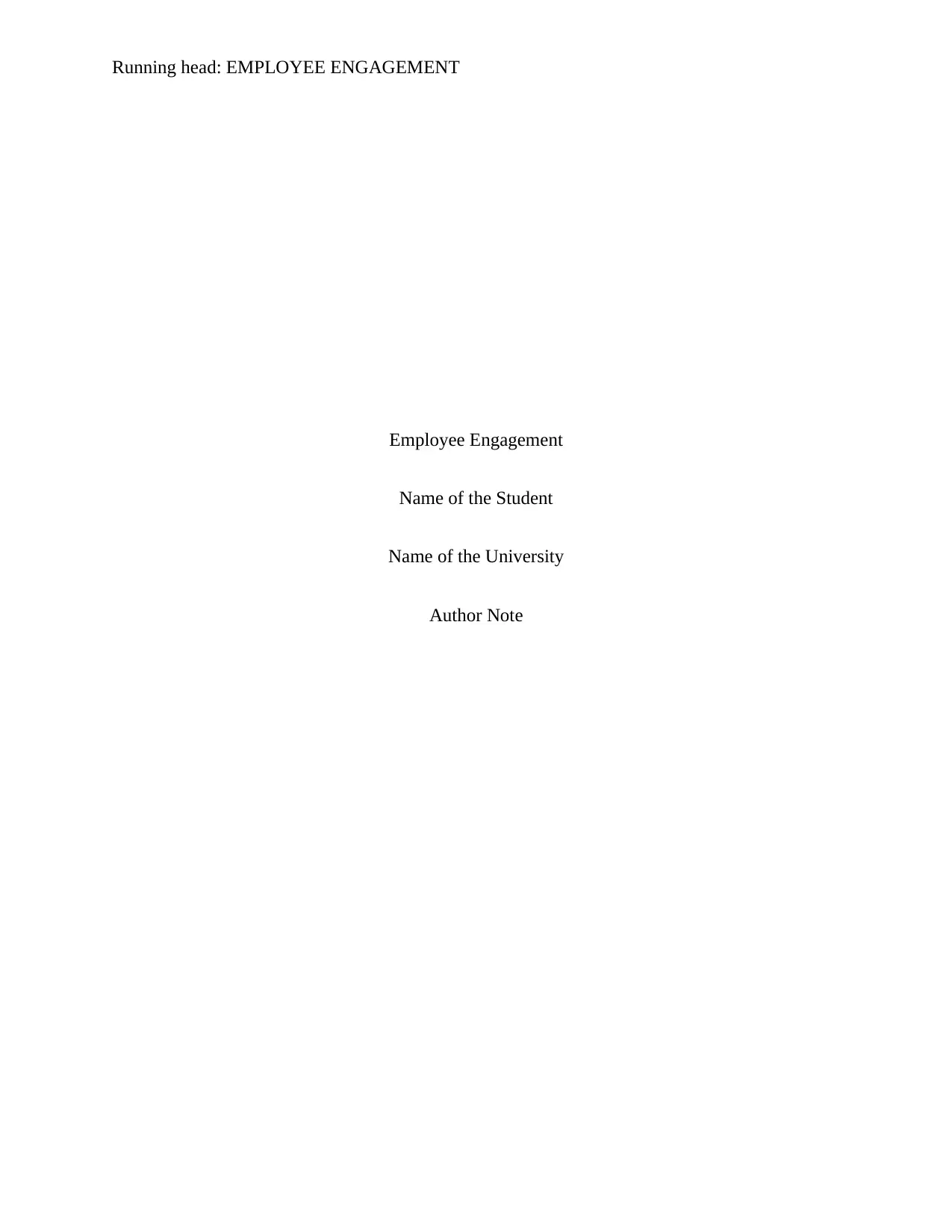
Running head: EMPLOYEE ENGAGEMENT
Employee Engagement
Name of the Student
Name of the University
Author Note
Employee Engagement
Name of the Student
Name of the University
Author Note
Paraphrase This Document
Need a fresh take? Get an instant paraphrase of this document with our AI Paraphraser
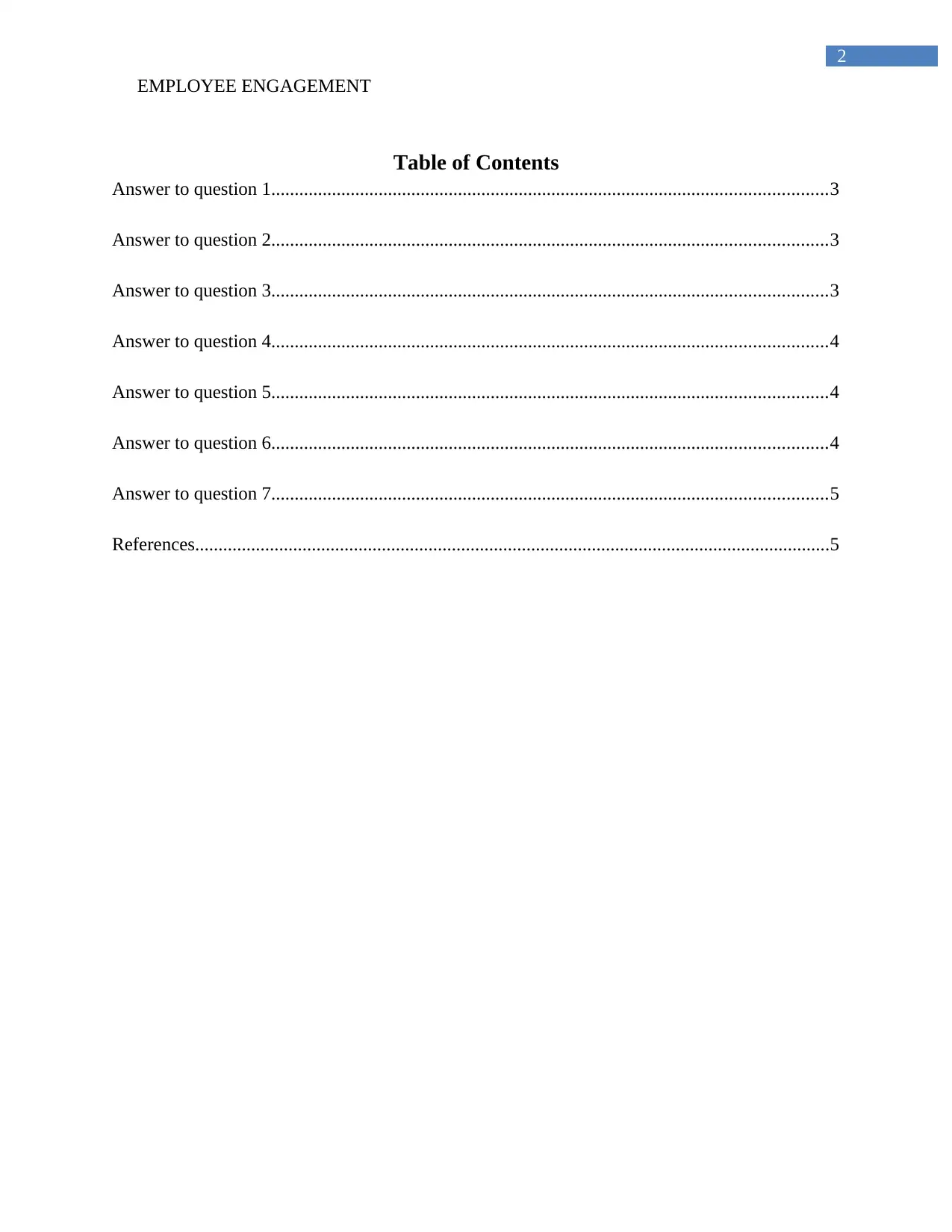
2
EMPLOYEE ENGAGEMENT
Table of Contents
Answer to question 1.......................................................................................................................3
Answer to question 2.......................................................................................................................3
Answer to question 3.......................................................................................................................3
Answer to question 4.......................................................................................................................4
Answer to question 5.......................................................................................................................4
Answer to question 6.......................................................................................................................4
Answer to question 7.......................................................................................................................5
References........................................................................................................................................5
EMPLOYEE ENGAGEMENT
Table of Contents
Answer to question 1.......................................................................................................................3
Answer to question 2.......................................................................................................................3
Answer to question 3.......................................................................................................................3
Answer to question 4.......................................................................................................................4
Answer to question 5.......................................................................................................................4
Answer to question 6.......................................................................................................................4
Answer to question 7.......................................................................................................................5
References........................................................................................................................................5
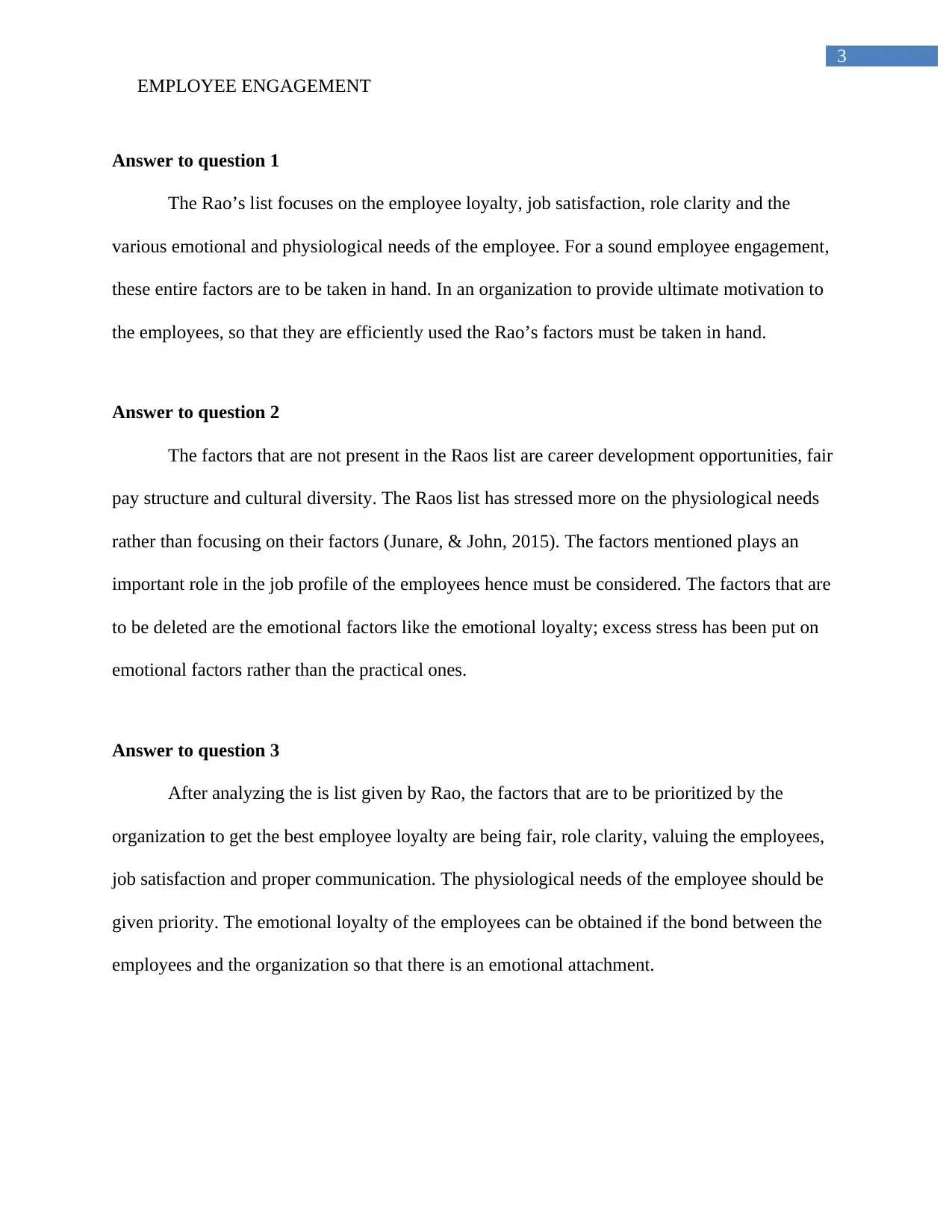
3
EMPLOYEE ENGAGEMENT
Answer to question 1
The Rao’s list focuses on the employee loyalty, job satisfaction, role clarity and the
various emotional and physiological needs of the employee. For a sound employee engagement,
these entire factors are to be taken in hand. In an organization to provide ultimate motivation to
the employees, so that they are efficiently used the Rao’s factors must be taken in hand.
Answer to question 2
The factors that are not present in the Raos list are career development opportunities, fair
pay structure and cultural diversity. The Raos list has stressed more on the physiological needs
rather than focusing on their factors (Junare, & John, 2015). The factors mentioned plays an
important role in the job profile of the employees hence must be considered. The factors that are
to be deleted are the emotional factors like the emotional loyalty; excess stress has been put on
emotional factors rather than the practical ones.
Answer to question 3
After analyzing the is list given by Rao, the factors that are to be prioritized by the
organization to get the best employee loyalty are being fair, role clarity, valuing the employees,
job satisfaction and proper communication. The physiological needs of the employee should be
given priority. The emotional loyalty of the employees can be obtained if the bond between the
employees and the organization so that there is an emotional attachment.
EMPLOYEE ENGAGEMENT
Answer to question 1
The Rao’s list focuses on the employee loyalty, job satisfaction, role clarity and the
various emotional and physiological needs of the employee. For a sound employee engagement,
these entire factors are to be taken in hand. In an organization to provide ultimate motivation to
the employees, so that they are efficiently used the Rao’s factors must be taken in hand.
Answer to question 2
The factors that are not present in the Raos list are career development opportunities, fair
pay structure and cultural diversity. The Raos list has stressed more on the physiological needs
rather than focusing on their factors (Junare, & John, 2015). The factors mentioned plays an
important role in the job profile of the employees hence must be considered. The factors that are
to be deleted are the emotional factors like the emotional loyalty; excess stress has been put on
emotional factors rather than the practical ones.
Answer to question 3
After analyzing the is list given by Rao, the factors that are to be prioritized by the
organization to get the best employee loyalty are being fair, role clarity, valuing the employees,
job satisfaction and proper communication. The physiological needs of the employee should be
given priority. The emotional loyalty of the employees can be obtained if the bond between the
employees and the organization so that there is an emotional attachment.
You're viewing a preview
Unlock full access by subscribing today!
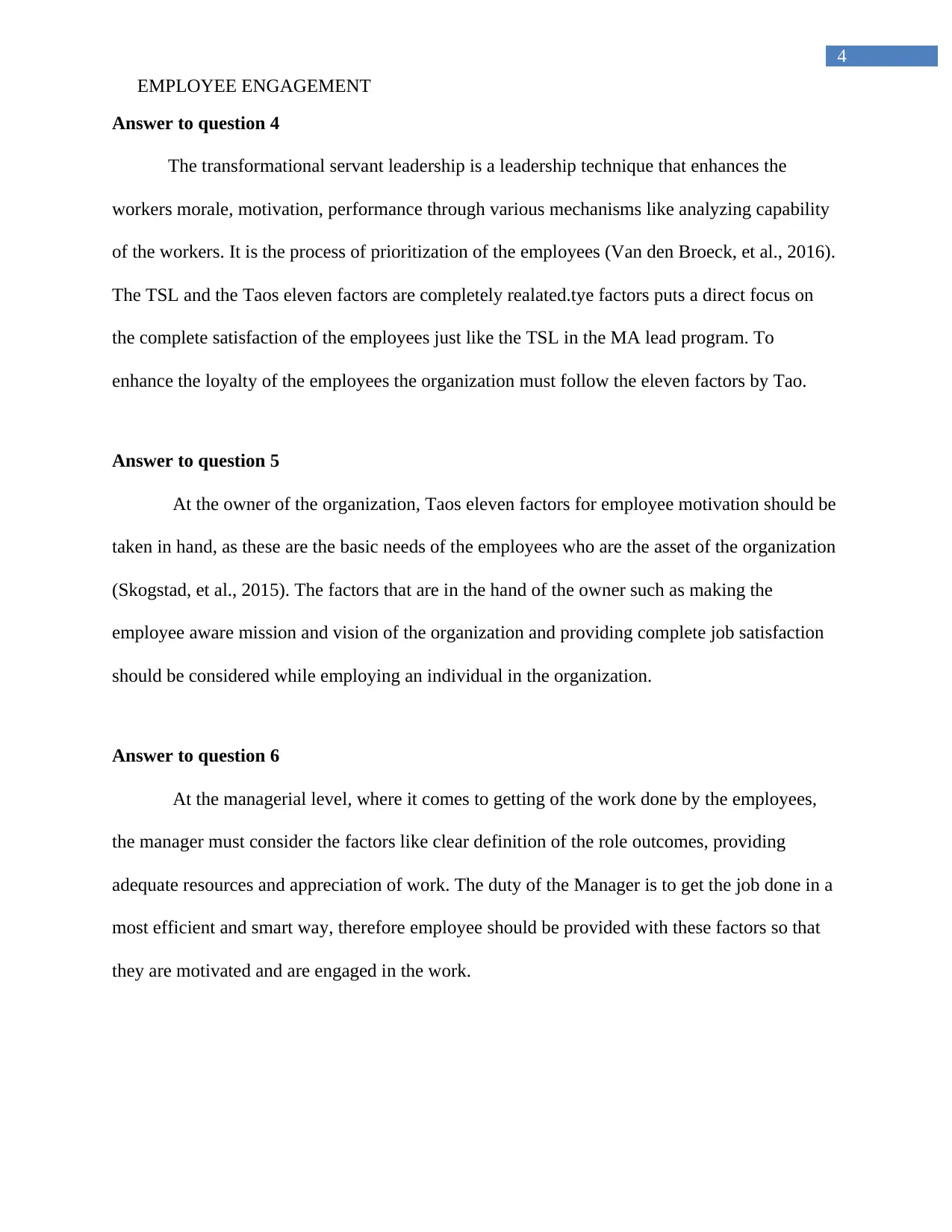
4
EMPLOYEE ENGAGEMENT
Answer to question 4
The transformational servant leadership is a leadership technique that enhances the
workers morale, motivation, performance through various mechanisms like analyzing capability
of the workers. It is the process of prioritization of the employees (Van den Broeck, et al., 2016).
The TSL and the Taos eleven factors are completely realated.tye factors puts a direct focus on
the complete satisfaction of the employees just like the TSL in the MA lead program. To
enhance the loyalty of the employees the organization must follow the eleven factors by Tao.
Answer to question 5
At the owner of the organization, Taos eleven factors for employee motivation should be
taken in hand, as these are the basic needs of the employees who are the asset of the organization
(Skogstad, et al., 2015). The factors that are in the hand of the owner such as making the
employee aware mission and vision of the organization and providing complete job satisfaction
should be considered while employing an individual in the organization.
Answer to question 6
At the managerial level, where it comes to getting of the work done by the employees,
the manager must consider the factors like clear definition of the role outcomes, providing
adequate resources and appreciation of work. The duty of the Manager is to get the job done in a
most efficient and smart way, therefore employee should be provided with these factors so that
they are motivated and are engaged in the work.
EMPLOYEE ENGAGEMENT
Answer to question 4
The transformational servant leadership is a leadership technique that enhances the
workers morale, motivation, performance through various mechanisms like analyzing capability
of the workers. It is the process of prioritization of the employees (Van den Broeck, et al., 2016).
The TSL and the Taos eleven factors are completely realated.tye factors puts a direct focus on
the complete satisfaction of the employees just like the TSL in the MA lead program. To
enhance the loyalty of the employees the organization must follow the eleven factors by Tao.
Answer to question 5
At the owner of the organization, Taos eleven factors for employee motivation should be
taken in hand, as these are the basic needs of the employees who are the asset of the organization
(Skogstad, et al., 2015). The factors that are in the hand of the owner such as making the
employee aware mission and vision of the organization and providing complete job satisfaction
should be considered while employing an individual in the organization.
Answer to question 6
At the managerial level, where it comes to getting of the work done by the employees,
the manager must consider the factors like clear definition of the role outcomes, providing
adequate resources and appreciation of work. The duty of the Manager is to get the job done in a
most efficient and smart way, therefore employee should be provided with these factors so that
they are motivated and are engaged in the work.
Paraphrase This Document
Need a fresh take? Get an instant paraphrase of this document with our AI Paraphraser
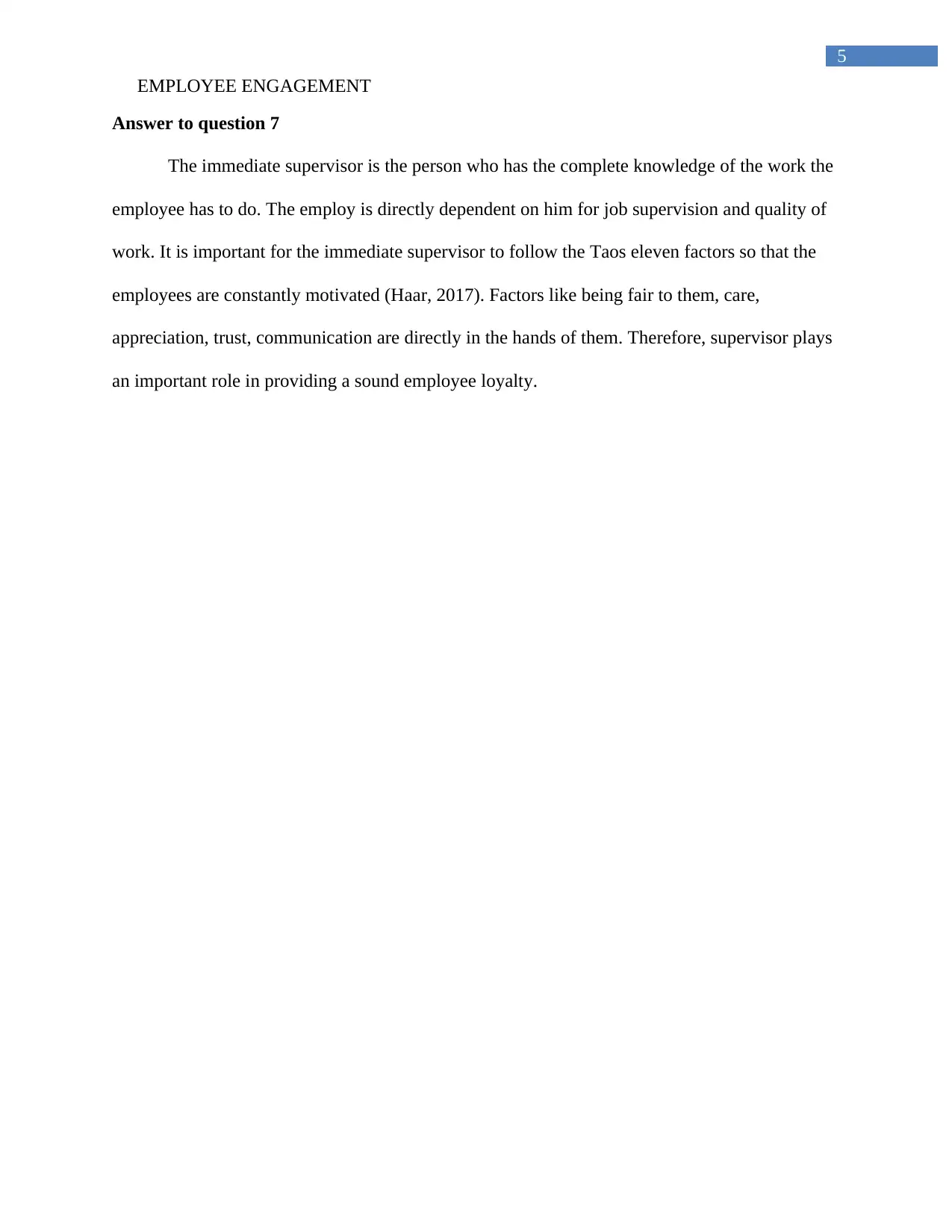
5
EMPLOYEE ENGAGEMENT
Answer to question 7
The immediate supervisor is the person who has the complete knowledge of the work the
employee has to do. The employ is directly dependent on him for job supervision and quality of
work. It is important for the immediate supervisor to follow the Taos eleven factors so that the
employees are constantly motivated (Haar, 2017). Factors like being fair to them, care,
appreciation, trust, communication are directly in the hands of them. Therefore, supervisor plays
an important role in providing a sound employee loyalty.
EMPLOYEE ENGAGEMENT
Answer to question 7
The immediate supervisor is the person who has the complete knowledge of the work the
employee has to do. The employ is directly dependent on him for job supervision and quality of
work. It is important for the immediate supervisor to follow the Taos eleven factors so that the
employees are constantly motivated (Haar, 2017). Factors like being fair to them, care,
appreciation, trust, communication are directly in the hands of them. Therefore, supervisor plays
an important role in providing a sound employee loyalty.
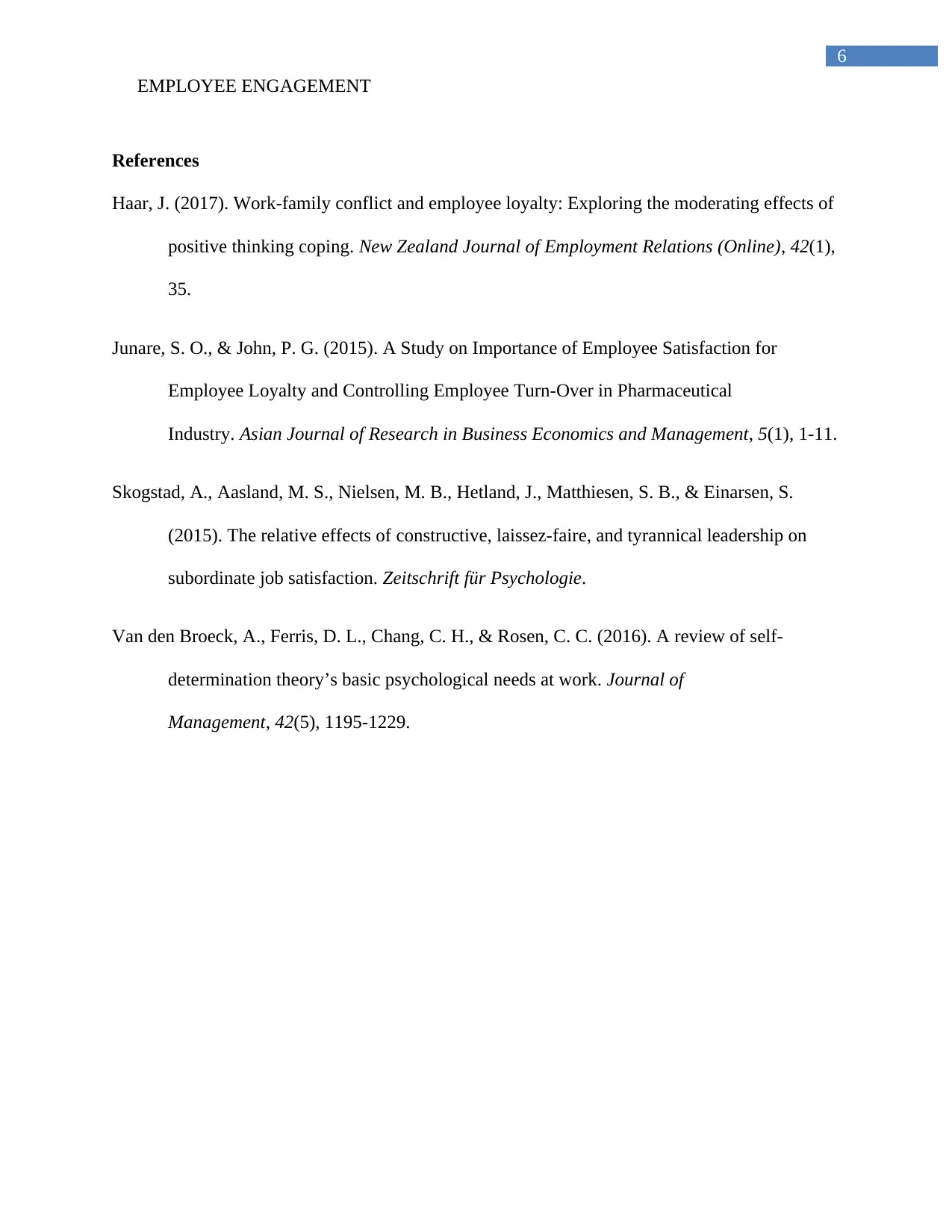
6
EMPLOYEE ENGAGEMENT
References
Haar, J. (2017). Work-family conflict and employee loyalty: Exploring the moderating effects of
positive thinking coping. New Zealand Journal of Employment Relations (Online), 42(1),
35.
Junare, S. O., & John, P. G. (2015). A Study on Importance of Employee Satisfaction for
Employee Loyalty and Controlling Employee Turn-Over in Pharmaceutical
Industry. Asian Journal of Research in Business Economics and Management, 5(1), 1-11.
Skogstad, A., Aasland, M. S., Nielsen, M. B., Hetland, J., Matthiesen, S. B., & Einarsen, S.
(2015). The relative effects of constructive, laissez-faire, and tyrannical leadership on
subordinate job satisfaction. Zeitschrift für Psychologie.
Van den Broeck, A., Ferris, D. L., Chang, C. H., & Rosen, C. C. (2016). A review of self-
determination theory’s basic psychological needs at work. Journal of
Management, 42(5), 1195-1229.
EMPLOYEE ENGAGEMENT
References
Haar, J. (2017). Work-family conflict and employee loyalty: Exploring the moderating effects of
positive thinking coping. New Zealand Journal of Employment Relations (Online), 42(1),
35.
Junare, S. O., & John, P. G. (2015). A Study on Importance of Employee Satisfaction for
Employee Loyalty and Controlling Employee Turn-Over in Pharmaceutical
Industry. Asian Journal of Research in Business Economics and Management, 5(1), 1-11.
Skogstad, A., Aasland, M. S., Nielsen, M. B., Hetland, J., Matthiesen, S. B., & Einarsen, S.
(2015). The relative effects of constructive, laissez-faire, and tyrannical leadership on
subordinate job satisfaction. Zeitschrift für Psychologie.
Van den Broeck, A., Ferris, D. L., Chang, C. H., & Rosen, C. C. (2016). A review of self-
determination theory’s basic psychological needs at work. Journal of
Management, 42(5), 1195-1229.
You're viewing a preview
Unlock full access by subscribing today!
1 out of 6
Related Documents
Your All-in-One AI-Powered Toolkit for Academic Success.
+13062052269
info@desklib.com
Available 24*7 on WhatsApp / Email
![[object Object]](/_next/static/media/star-bottom.7253800d.svg)
Unlock your academic potential
© 2024 | Zucol Services PVT LTD | All rights reserved.




